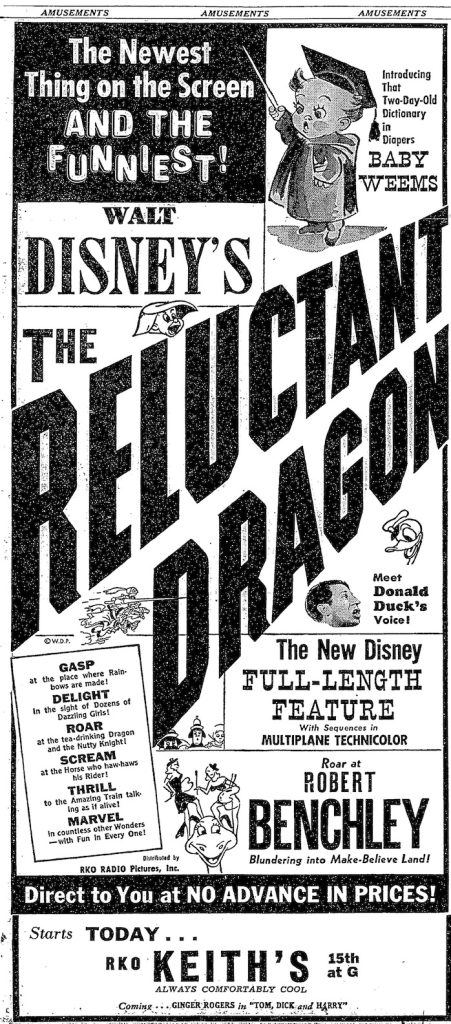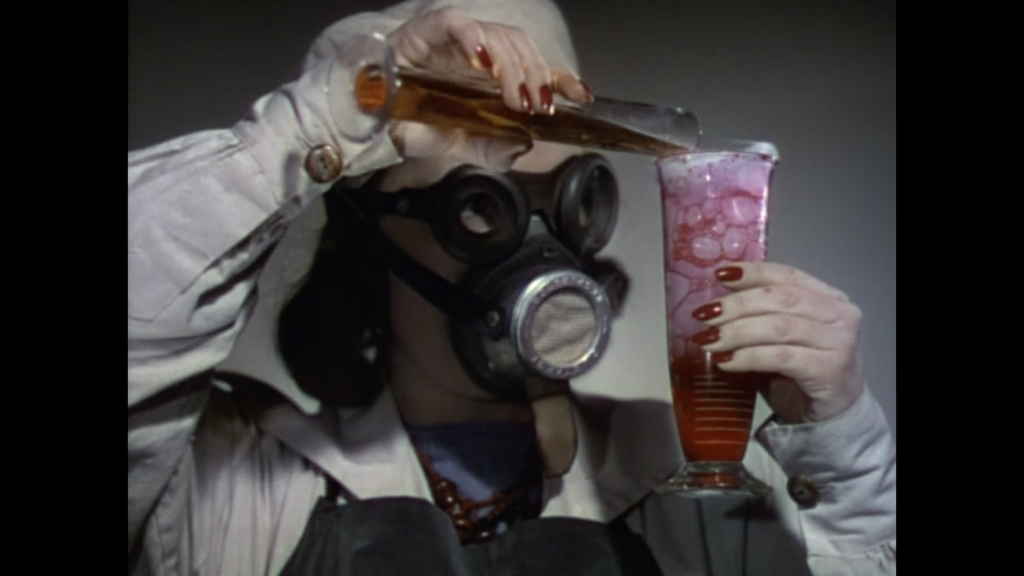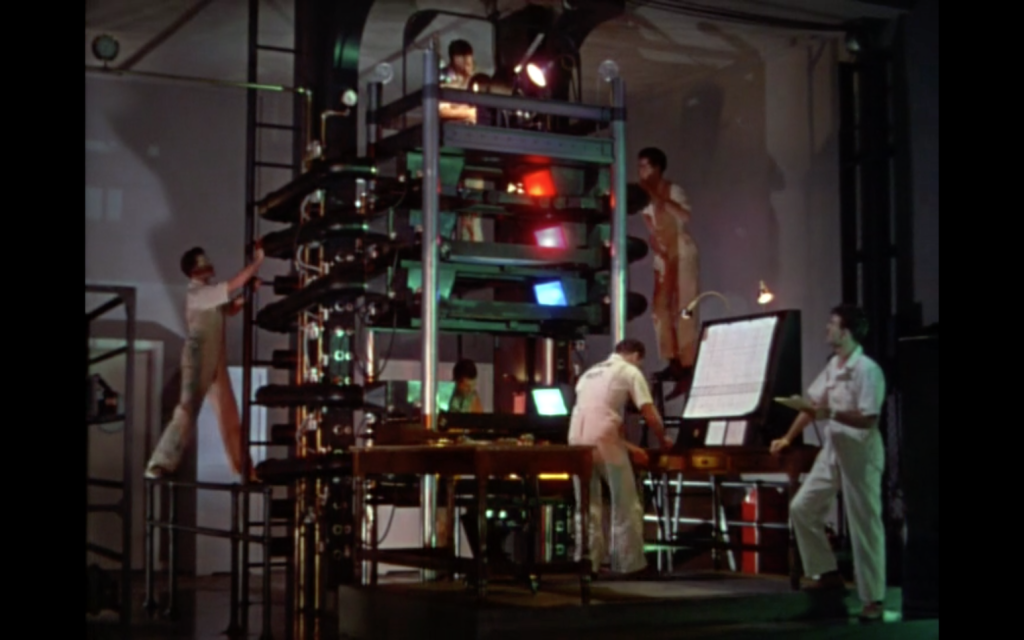When it comes to useful animation, many think of standard examples, such as motion graphics used in advertising or documentaries. However, useful films are any piece that is “made to sell, promote, or to teach” (Petter 2019, 74). While many (all?) of its films can be seen as selling and promoting itself and its ancillary properties (e.g., theme parks), the Walt Disney Studios created an entire film that explicitly promoted the company. Released in the summer of 1941, The Reluctant Dragon was a large departure from what the studio had done in the past. The film was built around a live-action plot that featured humorist Robert Benchley getting a tour of the company’s studios. During his visit, Benchley, acting as a surrogate for the audience, gets introduced to some of the animation process. The uniqueness of this film and the opportunity to see behind the filmmaking curtain, that is, its useful nature, was something that worked its way into both the advertising for the film as well as journalistic pieces previewing and reviewing the movie. On the one hand, the studio promoted this film as an exciting chance for the audience to learn about the company. On the other hand, critics, both prior to and after the film’s release, questioned whether or not a feature-length commercial was appropriate or needed.
The ads for Disney’s The Reluctant Dragon promised “a thousand surprises” for those who came to see the film. The ads also prominently displayed the technology featured in the movie, including Technicolor and the multiplane camera. Though the ads were often vague in terms of what the audience would actually see, there were definitely hints that it would not be like the traditional animated films they had seen before. One ad in the Washington Post (Jul 18, 1941, 7), for example, told audiences that they would “meet Donald Duck’s voice!” and the ad designers included the floating heads of Donald and his voice-actor, Clarence Nash. The ad also featured female models holding artist’s palettes and paintbrushes, a nod to the ink-and-paint girls who worked in, according to the ad, “the place where Rainbows are made!” This ad (see Figure 1), as well as others, provided hints that something was different, but the preview articles went further in revealing what was so unique about Disney’s newest feature-length release.
While there might have been some excitement around the new format and some of the content of the film, journalists both before and after The Reluctant Dragon’s release were not always sure or positive in discussing the film. Hubbard Keavy (1941), in his preview of the film for The Baltimore Sun, presents the uniqueness of the film, but makes no definitive remarks regards to its possible reception, even pointing to Disney’s own uncertainties: “And a very unorthodox motion picture it is, obeying scarcely any precedents. Because of that, I am sure none of us in Hollywood, knowing only movies that follow a pattern, can tell whether this will entertain or disillusion. Even Disney isn’t certain his public will like it. He can only hope he invested the million wisely” (SM7). For one New York Times reviewer, Disney’s gamble did not pay off in many ways. While pleased with the final animated short, the titular The Reluctant Dragon, the reviewer was unhappy with the live-action parts. The reviewer ultimately felt the film became too much of a promotion for the Disney studio:
But a good half, alas, is nothing more than a super deluxe commercial film showing Disney’s sumptuous new diggings out in San Fernando Valley. Perhaps there are hordes of people who will be delighted to learn that the voice of the immortal Donald is made by a man who “gets an air pocket in his cheek and thinks like a duck.” Perhaps there are others who will be fascinated by the mulitplane color camera on [sic] the delicately hued pigments of the “Rainbow Room.” But somehow we can’t get it out of our heads that in his Benchley’s eyeview of the studio he is palming off an oversized trailer for Disney products. (T.S. 1941, 12)
The author suggests that there might be some interest in the artists working on the film, as well as the technology used to create the magic of animation. Donald Kirkley (1941), writing for The Baltimore Sun, shared a similar view in terms of the promotional bent to the film, but did not see this necessarily as a problem: “In a sense, it is a full-length plug for the Disney studio, but complaints on this score are unlikely and irrelevant” (10).
While the reception of The Reluctant Dragon was mixed, the New York Times author, in their reactions, raises questions regarding the purpose of, and audience for, the film. They admit that there might be “hordes of people” interested in the behind-the-scenes views the film provides. While they are referring to people living at the time of the film’s release, their comment can also include those living long after the film was released and even when anyone associated with its production are no longer with us. This group of people can include the casual viewer or Disney fan, but it also can include historians working in a variety of fields (film, animation, technology, etc.). Kirsten Thompson (2014), for example, has examined the film’s presentation of the “Ink and Paint machine” in regard to gender and labor (see Figure 2).
My own work, presented at conferences, has examined the multiplane camera sequence and how that moment both reveals and hides the technology behind special effects animation (see Figure 3). So, in the end, while the film’s usefulness in terms of the studio’s original goals was debated at the time (“then”), the film remains a useful (though highly controlled) glimpse into the behind-the-scenes workings of animation practice for animation historians and others (“now”).
References
Keavey, H. (1941). Disney treads new movie bypath. The Baltimore Sun, 6 July.
Kirkley, D. (1941). “Reluctant Dragon:” Walt Disney’s latest film appears on screen at Hippodrome Theater. The Baltimore Sun, 1 August.
Petter, T. (2019). Sponsored silhouettes: Lotte Reiniger’s ‘useful’ films in Britain. In M. Cook & K. M. Thompson (Eds.), Animation and advertising (pp. 73-88). Palgrave Animation.
T.S. (1941). ‘The Reluctant Dragon,’ a Walt Disney compound of fact and fancy, opens at the Palace. The New York Times., 25 July.
Thompson, K. (2014). “Quick—like a bunny!” The ink and paint machine, female labor and color production. Animation Studies, 9.
Michael J. Meindl is an Assistant Professor of Media Production and co-director of Cinema and Screen Studies at Radford University (Radford, VA USA). He has an MFA in Dramatic Media from the University of Georgia, and he is currently a Ph.D. candidate in the Dept. of Science, Technology, and Society at Virginia Tech. He has presented at numerous regional, national, and international conferences. He has an essay entitled “You’re Gonna Need a Bigger Boom: Jaws, MythBusters, Science, and the Legacy of the Blockbuster” that will appear in an edited collection focused on Jaws. He also co-authored a piece called “Mojo Rising: Critiquing Mass Media through Animation and Comics” that will appear in an edited collection centered on X-Men: The Animated Series.



